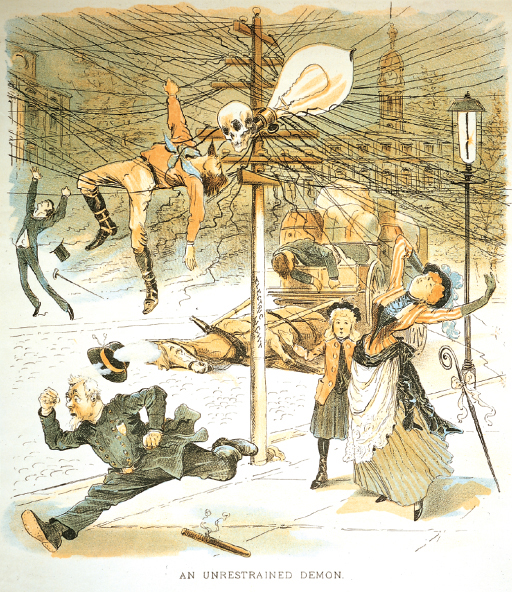New Inventions: The Telephone and the Telegraph
Printed Page 524
Table 18.1 Notable American Inventions, 1865–1899
Table 18.1 Notable American Inventions, 1865–1899
| 1865 | Railroad sleeping car |
| 1867 | Typewriter |
| 1868 | Railroad refrigerator car |
| 1870 | Stock ticker |
| 1874 | Barbed wire |
| 1876 | Telephone |
| 1877 | Phonograph |
| 1879 | Electric lightbulb |
| 1882 | Electric fan |
| 1885 | Adding machine |
| 1886 | Coca-Cola |
| 1888 | Kodak camera |
| 1890 | Electric chair |
| 1891 | Zipper |
| 1895 | Safety razor |
| 1896 | Electric stove |
| 1899 | Tape recorder |
The second half of the nineteenth century was an age of invention (Table 18.1). Men like Thomas Alva Edison and Alexander Graham Bell became folk heroes. But no matter how dramatic the inventors or the inventions, the new electric and telephone industries pioneered by Edison and Bell soon eclipsed their inventors and fell under the control of bankers and industrialists.
Alexander Graham Bell came to America from Scotland at the age of twenty-four with a passion to find a way to teach the deaf to speak (his wife and mother were deaf). Instead, he developed a way to transmit voice over wire — the telephone. Bell’s invention astounded the world when he demonstrated it at the Philadelphia Centennial Exposition in 1876. In 1880, Bell’s company, American Bell, pioneered “long lines” (long-distance telephone service), creating American Telephone and Telegraph (AT&T) as a subsidiary. In 1900, AT&T developed a complicated structure that enabled Americans to communicate not only locally but also across the country. And unlike a telegraph message, the telephone connected both parties immediately and privately. Bell’s invention proved a boon to business, contributing to speed and efficiency. The number of telephones soared, reaching 310,000 in 1895 and more than 1.5 million in 1900.
CHAPTER LOCATOR
How did the railroads stimulate big business?
Why did the ideas of social Darwinism appeal to many Americans in the late nineteenth century?
What factors influenced political life in the late nineteenth century?
What issues shaped party politics in the late nineteenth century?
What role did economic issues play in party realignment?
Conclusion: Why did business dominate the Gilded Age?
 LearningCurve
LearningCurve
Check what you know.
Even more than Alexander Graham Bell, inventor Thomas Alva Edison embodied the old-fashioned virtues of Yankee ingenuity and rugged individualism that Americans most admired. A self-educated dynamo, he worked twenty hours a day in his laboratory in Menlo Park, New Jersey, vowing to turn out “a minor invention every ten days and a big thing every six months or so.” He almost made good on his promise. At the height of his career, he averaged a patent every eleven days and invented such “big things” as the phonograph, the motion picture camera, and the filament for the incandescent lightbulb.

Edison, in competition with George W. Westinghouse, pioneered the use of electricity as an energy source. By the late nineteenth century, electricity had become a part of American urban life. It powered trolley cars and lighted factories, homes, and office buildings. Indeed, electricity became so prevalent in urban life that it symbolized the city, whose bright lights contrasted with rural America, left largely in the dark.
The day of the inventor quietly yielded to the heyday of the corporation. In 1892, the electric industry consolidated. Reflecting a nationwide trend in business, Edison General Electric dropped the name of its inventor, becoming simply General Electric (GE). For years, an embittered Edison refused to set foot inside a GE building. GE, a prime example of the trend toward business consolidation, soon dominated the market.
QUICK REVIEW
Question
What tactics and strategies did American business owners employ during the Gilded Age?